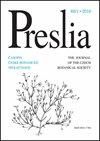捷克植物区系物种的生态特化指数
IF 4.4
2区 生物学
Q1 PLANT SCIENCES
引用次数: 16
摘要
物种生态专门化的概念在理论上是非常有用的,但由于缺乏相关的环境数据,在实践中往往难以量化。我们引入了生态专门化指数(ESI),它描述了一个物种在多个环境梯度上基于其实现的生态位的专门化程度,并在概念上基于Fridley等人(2007)引入的共生专门化度量theta。我们估算了捷克国家植物社会学数据库中至少10个植被样地的植物种的ESI。我们从三个数据集(i)所有植被类型的样地(ESIw, 1597种),(ii)仅非森林植被样地(ESInf, 1529种)和(iii)仅森林植被样地(ESIf, 881种)中计算了三组ESI值。我们还提供了数据集中物种的频率,因为计算出的ESI值的可靠性随着物种频率的增加而增加。这些ESI值的使用仅限于捷克共和国,在物种较少的情况下,该值可能受到抽样偏差的影响。为了更好地理解ESI的生态学意义,我们将ESIw的计算值与几个物种属性联系起来,并将其应用于深河谷当地植被数据集的案例研究。我们发现ESI与基于焦点物种发生的植物社会学关联数量和栖息地的专业化指标显著相关。在国家红色名录中被列入高风险类别的物种平均比受威胁程度较低的物种更加专业化。新植物的专门化程度明显低于古植物和本地物种。当与捷克共和国的埃伦伯格型指标值相关时,专家往往更耐阴,更好地适应营养贫乏的土壤和pH值低或高(但不是中等)的土壤,以及温暖或寒冷(但不是中等)的栖息地。在对河谷斜坡上森林林下草本植物物种的案例研究中,我们发现专家们倾向于局限于较冷的朝北斜坡上较深的土壤,峡谷森林中的石质土壤和木本物种冠层较密的地点。相比之下,在侵蚀的南坡和冠层较开阔的场地上,浅岩屑土壤往往以多面体为主。ESI值的完整列表包含在本文的电子附录中。本文章由计算机程序翻译,如有差异,请以英文原文为准。
Ecological specialization indices for species of the Czech flora
Theoretically the concept of species ecological specialization is very useful, however, practically it is often difficult to quantify due to a lack of relevant environmental data. We introduce the Ecological Specialization Index (ESI), which describes the degree of specialization of a species based on its realized niche along multiple environmental gradients and is conceptually based on the co-occurrence specialization metric theta introduced by Fridley et al. (2007). We estimated ESI for species of the Czech flora occurring in at least 10 vegetation plots stored in the Czech National Phytosociological Database. We prepared three sets of ESI values calculated from three datasets including (i) plots of all vegetation types (ESIw, 1597 species), (ii) only plots of non-forest vegetation (ESInf, 1529 species), and (iii) only plots of forest vegetation (ESIf, 881 species). We also provide the frequency of species in the datasets, since the reliability of the calculated ESI values increases with the species frequency. The use of these ESI values is limited to the Czech Republic, and in the case of less frequent species, the value can be influenced by sampling bias. To facilitate understanding of the ecological meaning of ESI, we related the calculated values of ESIw to several species attributes and applied them in a case study using a local vegetation dataset from a deep river valley. We found that ESI correlates significantly with specialization metrics based on the number of phytosociological associations and habitats in which the focal species occur. The species listed in the national Red List in higher risk categories are on average more specialized than less threatened species. Neophytes tend to be significantly less specialized than archaeophytes and native species. When related to Ellenberg-type indicator values for the Czech Republic, specialists tend to be more shade-tolerant, better adapted to nutrient-poor soils and soils with either a low or high (but not intermediate) pH and to either warm or cold (but not intermediate) habitats. In a case study of herbaceous plants species in a forest understory on river valley slopes, we found that specialists tend to be confined to deeper soils on cooler north-facing slopes, to stony soils in ravine forests and sites with a denser canopy of woody species. In contrast, shallow lithic soils on eroded south-facing slopes and sites with a more open canopy tend to be dominated by generalists. The complete list of ESI values is included in an electronic appendix to this paper.
求助全文
通过发布文献求助,成功后即可免费获取论文全文。
去求助
来源期刊

Preslia
生物-植物科学
CiteScore
5.20
自引率
29.40%
发文量
8
审稿时长
>12 weeks
期刊介绍:
Preslia is a peer-reviewed scientific journal publishing original research papers on plant systematics, morphology, phytogeography, ecology and vegetation science, with a geographical focus on central Europe. The journal was founded in 1914 and named in honour of brothers Jan Svatopluk Presl (1791–1849) and Karel Bořivoj Presl (1794–1852), outstanding Bohemian botanists. It is published quarterly by the Czech Botanical Society.
 求助内容:
求助内容: 应助结果提醒方式:
应助结果提醒方式:


